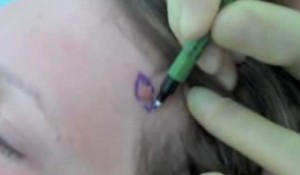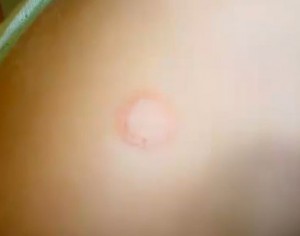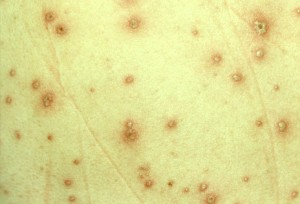The presence of bumps, sores, lumps, colored areas or ulcers on the skin is referred to as skin lesions. Common skin lesions found in individuals are warts, moles and actinic keratosis.
A skin mole that is normal is black, brown or tanned, circular and generally less than a quarter of an inch in diameter. On the other hand, skin lesions that those moles that have changed in color, shape or size. Some other symptoms of skin lesion include abnormal lumps that bleed, ooze fluids, increase in size, become crusty or scaly and contain blood vessels.
Individuals need to undergo a skin biopsy to determine the presence of skin lesions. Depending on the type of skin lesion, the doctor may recommend a number of treatment methods.
Skin lesions symptoms
In order to understand skin lesions, one needs to know anatomy of the skin. The skin has three main layers.
- The epidermis is the topmost layer and is superficial in nature. It can be divided into five layers and the top layer of epidermis is made up of flat and dead skin cells that shed every two weeks. The epidermis is very thick at the soles and extremely thin on the ears.
- The dermis lies beneath the epidermis and contains nerves, blood vessels, hair follicles and sweat glands. It has two layers that contain a connective tissue known as collagen. The number of structures and thickness of dermis varies as per the body part.
- The lowermost part of the skin is called the subcutaneous layer and consists of nerves and blood vessels. It is mainly composed of connective tissue and fat.
Now, we need to understand the characteristics of a normal mole, which are as follows:
- It is less that 6 mm in diameter
- It is brown, tan or black in color
- It has a circular or oval shape with sharp borders
- It has a symmetric shape wherein both the sides of the mole are identical.
An abnormal skin lesion has the following characteristics:
- Skin lumps that crack or bleed
- Skin lumps with inconsistent or irregular colors
- Skin lumps that have asymmetrical borders
- Skin lumps that change shape or size
- Moles that are larger than a quarter of an inch in diameter
- Moles whose appearance changes
- New growth in skin that elevates above the surface of the skin
- One side of the skin lesion differs in appearance to the other
- A new skin bump or skin lump on the skin
- Skin lesions that fail to heal
- Skin growth that is crusty, scaly or oozing liquids
- Skin growth or lesions that contain blood vessels
Causes of skin lesions
Some of the causes of skin lesions are listed below:
- Moles
- Cafe-Au-Lait spots
- Actinic keratosis which results in the development of brown or red spots on the skin. Such skin has generally been overexposed to the sun and tends to affect individuals over forty years of age
- Cutaneous horn
- Keloids
- Freckles
- Seborrheic keratosis
- Skin ulcer
- Skin cancer such as squamous cell carcinoma, basal cell carcinoma and malignant melanoma
- Skin abscess
- Infection with ringworm
- Cellulitis which refers to the infection of skin layers that are found deep within the skin
- Presence of warts on the skin
- Molluscum contagiosum which is condition of the skin caused by a viral infection
Some of the risk factors that increase the vulnerability to developing skin lesions are as follows:
- The presence of blue eyes, red or blonde hair
- An increased age
- Presence of freckles on the upper back region
- Exposure to toxic chemicals
- The presence of large moles
- A family history of various types of skin cancer
- Presence of skin ulcers
- Cancer treatment methods such as radiation therapy
- Increased exposure to the sun
- Jobs or occupations that involve working in open environments or outdoors
Skin lesion treatment
Skin lesion treatment is determined by the type of skin lesion. The treatment for a skin lesion may involve the use of topical medications, corticosteroid drugs, surgery, freezing the lesion or laser therapy.
Some of the treatment methods for skin lesion are discussed below:
- The doctor may prescribe the use of nonsteroidal anti-inflammatory drugs such as naproxen, ibuprofen or ketoprofen and/or oral corticosteroid drugs such as medrol or prednisone and/or topical corticosteroid drugs such as triamcinolone, aristocort or valisone.
- In case the skin lesion is caused by an infection of the skin, then the doctor may advise the intake of antibiotics
- Laser therapy may be used to burn the skin lesions
- Cryotherapy may be used to freeze the lesions at sub zero temperatures
- Surgery may be performed to physically remove the skin lesion
Additionally, individuals may also take the following self care measures to for alleviating the symptoms of skin lesions:
- Avoid excess exposure to the sun. Always use a sunscreen, when you known that you are going to be out in the sun for long periods and wear enough clothing to protect the skin from undue sun exposure
- Regularly examine the skin and check for any signs of skin cancer. Regular visits to a dermatologist is advisable
- Immediately consult a doctor in case of new skin growths or if present skin lesions have changed in shape, size or color
Avoid environments which have greater risks to chemical exposure.
Skin lesion pictures




I have similar lesions on my arm and chest as the second picture do you know what that is from?